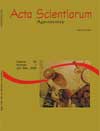<b>Relative efficiencies of selection methods of inbred families in popcorn</b> - DOI: 10.4025/actasciagron.v31i2.578
Keywords:
combined selection, Zea mays, popping expansion
Abstract
The study aimed to evaluate the relative efficiency of mass selection, among, within and of proposed new index of combined selection. The index, based on genealogy, was obtained by: , where is the phenotypic value of the plant Sn-1; is the phenotypic value of the Sn family, descendant of the Sn-1 plant; b1 is the weight of the individual phenotypic value, and b2 it is the weight of the phenotypic value of Sn family. The weights were obtained by derivation, assuming that they minimize the variance of the difference between the index and the value of the plant genetic additive Sn-1. To compare the methods, families and inbred plants were used, obtained from the population of Viçosa. A selection was made for popping expansion, using the three methods in S1, S2, S3 and S4 generations, and the efficiency of the methods of comparing averages in popping expansion of descendants of families selected by each method in S2, S3, S4 and S5 was assessed. For comparison of averages, the t-test at 5% of probability was used. It is concluded that the combined selection proposal was superior to the mass selection and was, in general, higher than the selection among and within. The selection among and within was, in general, higher than the mass selection.Downloads
Download data is not yet available.
Published
2009-05-14
How to Cite
Arnhold, E., Viana, J. M. S., Silva, R. G., & Mora, F. (2009). <b>Relative efficiencies of selection methods of inbred families in popcorn</b> - DOI: 10.4025/actasciagron.v31i2.578. Acta Scientiarum. Agronomy, 31(2), 203-207. https://doi.org/10.4025/actasciagron.v31i2.578
Issue
Section
Genetics and Plant Breeding
DECLARATION OF ORIGINALITY AND COPYRIGHTS
I Declare that current article is original and has not been submitted for publication, in part or in whole, to any other national or international journal.
The copyrights belong exclusively to the authors. Published content is licensed under Creative Commons Attribution 4.0 (CC BY 4.0) guidelines, which allows sharing (copy and distribution of the material in any medium or format) and adaptation (remix, transform, and build upon the material) for any purpose, even commercially, under the terms of attribution.
2.0
2019CiteScore
60th percentile
Powered by 

2.0
2019CiteScore
60th percentile
Powered by 



















































